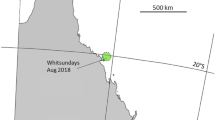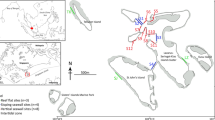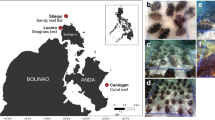Abstract
Tropical and temperate marine habitats have long been recognised as fundamentally different system, yet comparative studies are rare, particularly for small organisms such as Crustacea. This study investigates the ecological attributes (abundance, biomass and estimated productivity) of benthic Crustacea in selected microhabitats from a tropical and a temperate location, revealing marked differences in the crustacean assemblages. In general, microhabitats from the tropical location (dead coral, the epilithic algal matrix [algal turfs] and sand) supported high abundances of small individuals (mean length = 0.53 mm vs. 0.96 mm in temperate microhabitats), while temperate microhabitats (the brown seaweed Carpophyllum sp., coralline turf and sand) had substantially greater biomasses of crustaceans and higher estimated productivity rates. In both locations, the most important microhabitats for crustaceans (per unit area) were complex structures: tropical dead coral and temperate Carpophyllum sp. It appears that the differences between microhabitats are largely driven by the size and relative abundance of key crustacean groups. Temperate microhabitats have a higher proportion of relatively large Peracarida (Amphipoda and Isopoda), whereas tropical microhabitats are dominated by small detrital- and microalgal-feeding crustaceans (harpacticoid copepods and ostracods). These differences highlight the vulnerability of tropical and temperate systems to the loss of complex benthic structures and their associated crustacean assemblages.




Similar content being viewed by others
References
Ayling AM (1981) The role of biological disturbance in temperate subtidal encrusting communities. Ecology 62:830–847
Bartholomew A, Diaz RJ, Cicchetti G (2000) New dimensionless indices of structural habitat complexity: predicted and actual effects on a predator’s foraging success. Mar Ecol Prog Ser 206:45–58
Bellwood DR, Goatley CHR, Bellwood O (2017) The evolution of fishes and corals on reefs: form, function and interdependence. Biol Rev Camb Philos Soc 92:878–901
Bellwood DR, Wainwright PC, Fulton CJ, Hoey AS (2006) Functional versatility supports coral reef biodiversity. Proc R Soc Lond B Biol Sci 273:101–107
Bellwood DR, Hoey AS, Bellwood O, Goatley CHR (2014) Evolution of long-toothed fishes and the changing nature of fish–benthos interactions on coral reefs. Nat Commun 5:3144
Berthelsen AK, Taylor RB (2014) Arthropod mesograzers reduce epiphytic overgrowth of subtidal coralline turf. Mar Ecol Prog Ser 515:123–132
Berthelsen AK, Hewitt JE, Taylor RB (2015) Coralline turf-associated fauna are affected more by spatial variability than by host species identity. Marine Biodiversity 45:689
Brandl SJ, Emslie MJ, Ceccarelli DM, Richards ZT (2016) Habitat degradation increases functional originality in highly diverse coral reef fish assemblages. Ecosphere 7:e01557
Carleton JH, McKinnon AD (2007) Resident mysids: secondary production, consumption, and trophic role in a coral reef lagoon. Mar Ecol Prog Ser 336:89–98
Chapelle G, Peck LS (2004) Amphipod crustacean size spectra: new insights in the relationship between size and oxygen. Oikos 106:167–175
Choat JH (1982) Fish feeding and the structure of benthic communities in temperate waters. Annu Rev Ecol Syst 13:423–449
Choat JH, Kingett PD (1982) The influence of fish predation on the abundance cycles of an algal turf invertebrate fauna. Oecologia 54:88–95
Cnudde C, Moens T, Werbrouck E, Lepoint G, Van Gansbeke D, De Troch M (2015) Trophodynamics of estuarine intertidal harpacticoid copepods based on stable isotope composition and fatty acid profiles. Mar Ecol Prog Ser 524:225–239
Connell SD, Russell BD, Turner DJ, Shepherd SA, Kildea T, Miller D, Airoldi L, Cheshire A (2008) Recovering a lost baseline: missing kelp forests from a metropolitan coast. Mar Ecol Prog Ser 360:63–72
Cowles A, Hewitt JE, Taylor RB (2009) Density, biomass and productivity of small mobile invertebrates in a wide range of coastal habitats. Mar Ecol Prog Ser 384:175–185
Cowman PF, Bellwood DR, van Herwerden L (2009) Dating the evolutionary origins of wrasse lineages (Labridae) and the rise of trophic novelty on coral reefs. Mol Phylogenet Evol 52:621–631
Doropoulos C, Hyndes GA, Lavery PS, Tuya F (2009) Dietary preferences of two seagrass-inhabiting gastropods: allochthonous vs. autochthonous resources. Estuar Coast Shelf Sci 83:13–18
Duffy JE (1990) Amphipods on seaweeds: partners or pests? Oecologia 83:267–276
Duffy JE, Hay ME (2000) Strong impacts of grazing amphipods on the organization of a benthic community. Ecol Monogr 70:237–263
Edgar GJ (1990) The use of the size structure of benthic macrofaunal communities to estimate faunal biomass and secondary production. J Exp Mar Bio Ecol 137:195–214
Edgar GJ, Moore P (1986) Macro-algae as habitats for motile macrofauna. Monografias Biologicas 4:255–277
Edgar GJ, Shaw C (1995a) The production and trophic ecology of shallow-water fish assemblages in southern Australia II. Diets of fishes and trophic relationships between fishes and benthos at Western Port, Victoria. J Exp Mar Bio Ecol 194:83–106
Edgar GJ, Shaw C (1995b) The production and trophic ecology of shallow-water fish assemblages in southern Australia III. General relationships between sediments, seagrasses, invertebrates and fishes. J Exp Mar Bio Ecol 194:107–131
Enochs IC (2012) Motile cryptofauna associated with live and dead coral substrates: implications for coral mortality and framework erosion. Mar Biol 159:709–722
Fox RJ, Bellwood DR (2007) Quantifying herbivory across a coral reef depth gradient. Mar Ecol Prog Ser 339:49–59
Gacia E, Costalago D, Prado P, Piorno D, Tomas F (2009) Mesograzers in Posidonia oceanica meadows: an update of data on gastropod–epiphyte–seagrass interactions. Botanica Marina 52:439–447
Glynn PW, Enochs IC (2011) Invertebrates and their roles in coral reef ecosystems. In: Dubinsky Z, Stambler N (eds) Coral reefs: an ecosystem in transition. Springer, Netherlands, pp 273–325
Goatley CHR, Bellwood DR (2010) Biologically mediated sediment fluxes on coral reefs: sediment removal and off-reef transportation by the surgeonfish Ctenochaetus striatus. Mar Ecol Prog Ser 415:237–245
Goatley CHR, Bellwood DR (2011) The roles of dimensionality, canopies and complexity in ecosystem monitoring. PLoS One 6:e27307
Goatley CHR, Bonaldo RM, Fox RJ, Bellwood DR (2016) Sediments and herbivory as sensitive indicators of coral reef degradation. Ecol Soc 21:29
Holbrook SJ, Schmitt RJ, Ambrose RF (1990) Biogenic habitat structure and characteristics of temperate reef fish assemblages. Austral Ecol 15:489–503
Hughes TP, Kerry JT, Álvarez-Noriega M, Álvarez-Romero JG, Anderson KD, Baird AH, Babcock RC, Beger M, Bellwood DR, Berkelmans R, Bridge TCL, Butler I, Byrne M, Cantin NE, Comeau S, Connolly SR, Cumming GS, Dalton SJ, Diaz-Pulido G, Eakin M, Figueira W, Gilmour J, Harrison HB, Heron SF, Hoey AS, Hobbs J-PA, Hoogenboom MO, Kennedy EV, Kuo C-Y, Lough JM, Lowe RJ, Liu G, McCulloch MT, Malcolm H, McWilliam M, Pandolfi JM, Pears R, Pratchett MS, Schoepf V, Simpson T, Skirving W, Sommer B, Torda G, Wachenfeld D, Willis BL, Wilson SK (2017) Global warming and recurrent mass bleaching of corals. Nature 543:373–377
Jacoby CA, Greenwood JG (1988) Spatial, temporal and behavioural patterns in emergence of zooplankton in the lagoon of Heron Reef, Great Barrier Reef, Australia. Mar Biol 97:309–328
Jones GP (1988) Ecology of rocky reef fish of north-eastern New Zealand: a review. New Zealand Journal of Marine and Freshwater Research 22:445–462
Keable SJ (1995) Structure of the marine invertebrate scavenging guild of a tropical reef ecosystem: field studies at Lizard Island, Queensland, Australia. Journal of Natural History 29:27–45
Kelaher BP, Chapman MG, Underwood AJ (2001) Spatial patterns of diverse macrofaunal assemblages in coralline turf and their associations with environmental variables. J Mar Biol Assoc U K 81:917–930
Klumpp DW, McKinnon AD, Mundy CN (1988) Motile cryptofauna of a coral reef — abundance, distribution and trophic potential. Mar Ecol Prog Ser 45:95–108
Kramer MJ, Bellwood DR, Bellwood O (2012) Cryptofauna of the epilithic algal matrix on an inshore coral reef, Great Barrier Reef. Coral Reefs 31:1007–1015
Kramer MJ, Bellwood O, Bellwood DR (2013) The trophic importance of algal turfs for coral reef fishes: the crustacean link. Coral Reefs 32:575–583
Kramer MJ, Bellwood DR, Bellwood O (2014) Benthic Crustacea on coral reefs: a quantitative survey. Mar Ecol Prog Ser 511:105–116
Kramer MJ, Bellwood O, Fulton CJ, Bellwood DR (2015) Refining the invertivore: diversity and specialisation in fish predation on coral reef crustaceans. Mar Biol 162:1779–1786
Lawrence SG, Malley DF, Findlay WJ, Maclver MA, Delbaere IL (1987) Method for estimating dry weight of freshwater planktonic crustaceans from measures of length and shape. Can J Fish Aquat Sci 44:s264–s274
Leum LL, Choat JH (1980) Density and distribution patterns of the temperate marine fish Cheilodactylus spectabilis; (Cheilodactylidae) in a reef environment. Mar Biol 57:327–337
Logan D, Townsend KA, Townsend K, Tibbetts IR (2008) Meiofauna sediment relations in leeward slope turf algae of Heron Island reef. Hydrobiologia 610:269–276
Martin-Smith KM (1993) Abundance of mobile epifauna — the role of habitat complexity and predation by fishes. J Exp Mar Bio Ecol 174:243–260
Montagna PA, Blanchard GF, Dinet A (1995) Effect of production and biomass of intertidal microphytobenthos on meiofaunal grazing rates. J Exp Mar Bio Ecol 185:149–165
Nash KL, Graham NAJ, Jennings S, Wilson SK, Bellwood DR (2016) Herbivore cross-scale redundancy supports response diversity and promotes coral reef resilience. J Appl Ecol 53:646–655
Newcombe EM, Taylor RB (2010) Trophic cascade in a seaweed–epifauna–fish food chain. Mar Ecol Prog Ser 408:161–167
Plaisance L, Knowlton N, Paulay G, Meyer C (2009) Reef-associated crustacean fauna: biodiversity estimates using semi-quantitative sampling and DNA barcoding. Coral Reefs 28:977–986
Pratchett MS (2001) Influence of coral symbionts on feeding preferences of crown-of-thorns starfish Acanthaster planci in the western Pacific. Mar Ecol Prog Ser 214:111–119
Preston NP, Doherty PJ (1994) Cross-shelf patterns in the community structure of coral-dwelling Crustacea in the central region of the Great Barrier Reef. II. Cryptofauna. Mar Ecol Prog Ser 104:27–38
Randall JE, Allen GR, Steene RC (1997) Fishes of the Great Barrier Reef and Coral Sea. University of Hawaii Press, Honolulu, Hawaii
Ricciardi A, Bourget E (1998) Weight-to-weight conversion factors for marine benthic macroinvertebrates. Mar Ecol Prog Ser 163:245–251
Ruppert EE, Fox RS, Barnes RD (2004) Invertebrate zoology: a functional evolutionary approach. Thompson-Brooks/Cole, Belmont, CA
Russell BC (1983) The food and feeding habits of rocky reef fish of north-eastern New Zealand. New Zealand Journal of Marine and Freshwater Research 17:121–145
Stella JS, Munday PL, Jones GP (2011a) Effects of coral bleaching on the obligate coral-dwelling crab Trapezia cymodoce. Coral Reefs 30:719–727
Stella JS, Pratchett MS, Hutchings PA, Jones GP (2011b) Coral-associated invertebrates: diversity, ecological importance and vulnerability to disturbance. Oceanogr Mar Biol Annu Rev 49:43–104
Taylor RB (1998) Density, biomass and productivity of animals in four subtidal rocky reef habitats: the importance of small mobile invertebrates. Mar Ecol Prog Ser 172:37–51
Taylor RB (2015) Small free-living crustaceans. In: Thiel M, Watling L (eds) The natural history of the Crustacea, vol 2., Lifestyles and feeding biologyOxford University Press, United Kingdom, pp 229–261
Taylor RB, Cole RG (1994) Mobile epifauna on subtidal brown seaweeds in northeastern New Zealand. Mar Ecol Prog Ser 115:271–282
Tebbett SB, Goatley CHR, Bellwood DR (2017a) Clarifying functional roles: algal removal by the surgeonfishes Ctenochaetus striatus and Acanthurus nigrofuscus. Coral Reefs. doi:10.1007/s00338-017-1571-z
Tebbett SB, Goatley CHR, Bellwood DR (2017b) Fine sediments suppress detritivory on coral reefs. Mar Pollut Bull 114:934–940
Titford ME, Horenstein MG (2005) Histomorphologic assessment of formalin substitute fixatives for diagnostic surgical pathology. Arch Pathol Lab Med 129:502–506
Uthicke S, Klumpp DW (1998) Microphytobenthos community production at a near-shore coral reef: seasonal variation and response to ammonium recycled by holothurians. Mar Ecol Prog Ser 169:1–11
van Guelpen L, Markle DF, Duggan DJ (1982) An evaluation of accuracy, precision, and speed of several zooplankton subsampling techniques. ICES J Mar Sci 40:226–236
Wild C, Rasheed M, Jantzen C, Cook P, Struck U, Huettel M, Boetius A (2005) Benthic metabolism and degradation of natural particulate organic matter in carbonate and silicate reef sands of the northern Red Sea. Mar Ecol Prog Ser 298:69–78
Wilson SK, Bellwood DR, Choat JH, Furnas MJ (2003) Detritus in the epilithic algal matrix and its use by coral reef fishes. Oceanogr Mar Biol Annu Rev 41:279–309
Wing WR, Wing L (2015) Ontogenetic shifts in resource use by the sea urchin Evechinus chloroticus across an ecotone. Mar Ecol Prog Ser 535:177–184
Wismer S, Hoey AS, Bellwood DR (2009) Cross-shelf benthic community structure on the Great Barrier Reef: relationships between macroalgal cover and herbivore biomass. Mar Ecol Prog Ser 376:45–54
Acknowledgements
We would like to thank C. E. Mirbach, A. Spyksma, Leigh Marine Laboratory and Lizard Island Research Station for field support, J. Kramer, K. W. Kramer, and J. Tengvall for laboratory assistance, S. J. Brandl, S. B. Tebbett and M. Thiel for discussions and comments on earlier drafts, and three anonymous reviewers for helpful suggestions. This work was supported by the Australian Research Council (D. R. B.).
Author information
Authors and Affiliations
Corresponding author
Additional information
Communicated by Ecology Editor Dr. Alastair Harborne
Electronic supplementary material
Below is the link to the electronic supplementary material.
Rights and permissions
About this article
Cite this article
Kramer, M.J., Bellwood, D.R., Taylor, R.B. et al. Benthic Crustacea from tropical and temperate reef locations: differences in assemblages and their relationship with habitat structure. Coral Reefs 36, 971–980 (2017). https://doi.org/10.1007/s00338-017-1588-3
Received:
Accepted:
Published:
Issue Date:
DOI: https://doi.org/10.1007/s00338-017-1588-3




